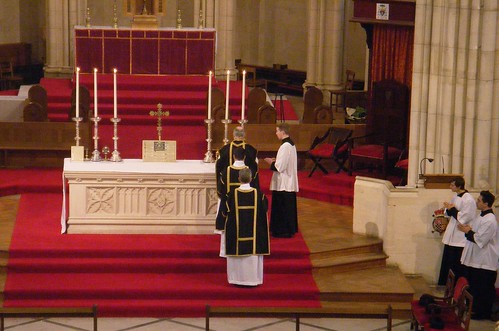
Traditional Latin Mass- Arundel Cathedral, a photo by Henry░Law on Flickr.
This would have been a rare sight even ten years ago, but with the publication of Summorum Pontificum in 2007, and the removal of the remaining restrictions on its use, the old rite (Tridentine) Mass is being celebrated quite frequently, at least in some places.
When the restrictions were lifted, people seem to have thought that it would be an exception, and hence it was styled the "Extraordinary Form" (EF), as against the Novus Ordo (NO) liturgy now termed the "Ordinary Form". What was perhaps not expected was that it is, though very slowly, becoming mainstream. A couple of parishes have adopted it as the main Sunday sung mass, whilst there is a growing number of Sunday celebrations once a month, and regular Low Masses on weekdays. Also surprising (or perhaps not so surprising), is that attendance is no longer exclusively by the ageing stalwarts who have supported the Latin Mass Society for the last forty years. A substantial contingent of under-30s is now typical in congregations at these liturgies.
Equally surprising is that an increasing number of parishioners with no special interest in the liturgy are comfortable with the EF Mass, and possibly more so now that the new English translation has come into use. This latter is a great improvement on the old translation and has prompted attempts at setting the new texts to the traditional Gregorian Chants. These are of mixed quality. The rhythms of the English language do not suit the Gregorian Chant, which is presumably why Anglican Chant was devised. An increasing use of Latin is also leading to liturgies which switch awkwardly and unpredictably between the two languages. The logical conclusion of this trend is to do everything in Latin apart from the readings, but in the NO, there is the long period when the Canon of the Mass is recited, which does not work particularly well in Latin, but which in the EF form is said silently whilst the choir is singing the Sanctus.
This difference, which is the most noticeable one to anyone in the congregation, means, perhaps surprisingly, that the EF Mass is more accessible than the newer form. A further benefit is that where parishes are ethnically mixed, not only is the Latin neutral ground, it would also help to unify parishes which have become divided into different national groups according to which mass they attend.
The sooner that parish priests realise this, the better.
Kommentarer